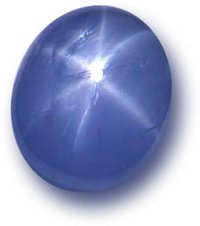Sapphire
|
|
- For other uses, see Sapphire (disambiguation).
 Asterism on the surface of a sapphire
Asterism on the surface of a sapphire
Sapphire is the single-crystal form of aluminium oxide (Al2O3), a mineral known as corundum. It can be found naturally as gemstones or manufactured in large crystal boules for a variety of applications.
Sapphire gems
Sapphire is any gemstone-quality corundum. (The red variety of corundum is also known as ruby.)
When color is not specified, sapphire refers to the blue variety. Pink, yellow, green, white, and parti-color (multi-colored) sapphires are often valued less than the blue variety of the same quality and size. However a pink-orange sapphire, called a Padparacha or Padparadja, is highly prized. They were found in many countries especially is Asia such as India, Sri Lanka, Thailand, Myanmar, and Cambodia.
It is the impurities in the aluminium oxide crystal that give the color variations, with different impurity chemical elements giving the different colors that can be found. Pure sapphire is transparent. The crystals are exceptionally hard, with only diamond being harder among natural gems. They have a hardness of 9 on the Mohs hardness scale (Diamond is 10).
As well as occurring naturally, gem quality sapphires and rubies can be easily and cheaply produced in the laboratory. The chemical compositions and physical properties are identical to the natural sapphires. The tell-tale sign of synthetic sapphires is the crystalline growth lines which are usually curved due to the pulling during the accelerated crystal growth process.
A version which shows an asterism is called a "star sapphire" (see picture above). Although natural sapphires can show an asterism, the shape of the star is usually somewhat irregular and sometimes indistinct. A manufactured star sapphire called the Linde Star shows a very regularly-shaped and distinct asterism because the formation process is more tightly controlled than the natural version.
The Logan sapphire is one of the largest blue sapphire gems known. It weighs 423 carats (84.6 g).
Lady Diana Spencer's engagement ring from Charles, Prince of Wales was a sapphire ring.
Cornflower blue is the most popular color for sapphires.
Sapphire is also the birthstone associated with September.
Synthetic sapphire for non-gemstone applications
Synthetic sapphire crystals can be grown in cylindrical crystal ingots of large size, up to many inches in diameter. As well as gemstone applications there are many other uses:
The first ever laser produced was based on the ruby chromium impurity in sapphire. While this laser has few commercial applications, the Ti-sapphire laser is popular due the relatively rare ability to tune the laser wavelength in the red-to-near infrared region of the electromagnetic spectrum. It can also be easily modelocked. In these lasers, a synthetically produced sapphire crystal with chromium or titanium impurities is irradiated with intense light from a special lamp, or another laser, to create the stimulated emission.
Pure sapphire ingots can be sliced into wafers and polished to form transparent crystal slices. Such slices are used as watch faces in high quality watches, as the material's exceptional hardness makes the face almost impossible to scratch.
Wafers of single crystal sapphire are also used in the semiconductor industry as a substrate for the growth of gallium nitride based blue and green light emitting diodes.
See also
bg:Сапфир da:Safir de:Saphir et:Safiir fr:Saphir ja:サファイア nl:Saffier pl:Szafir pt:Safira sv:Safir zh:蓝宝石
